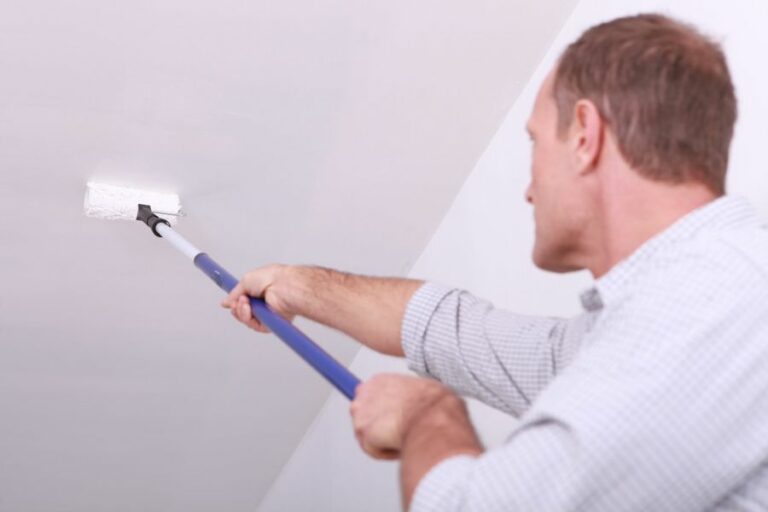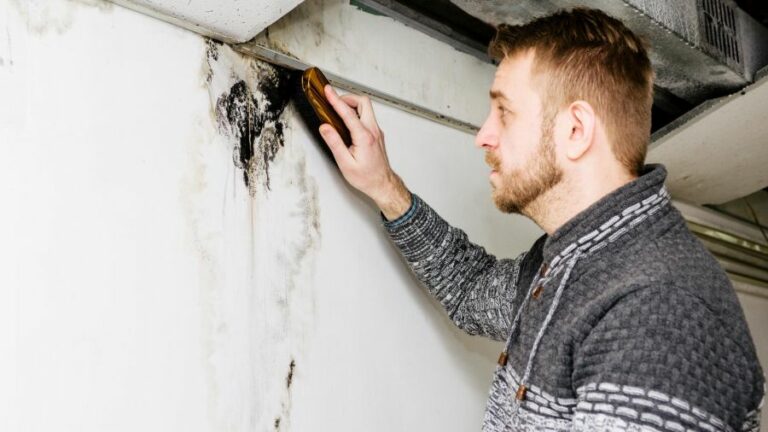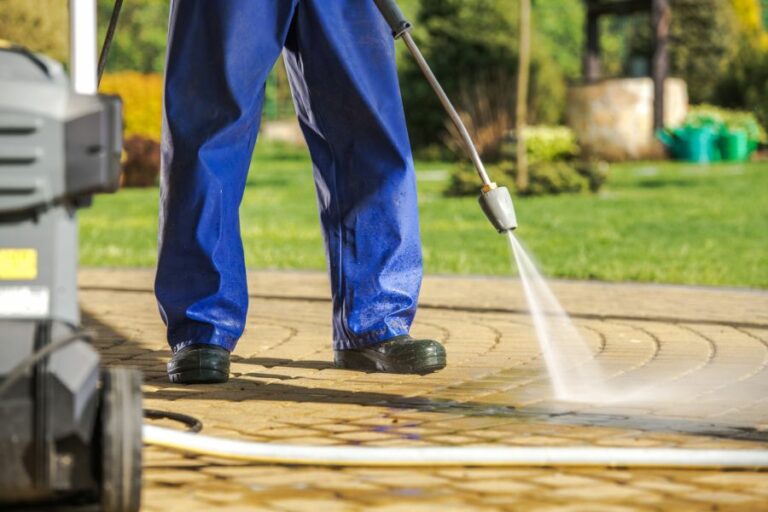Importance Of Degreasing And Cleaning Before Paint
When achieving professional-level paint results, there’s no denying that proper surface preparation is a crucial first step. Indeed, if there’s one thing nearly all experts can agree on, the importance of degreasing and cleaning before painting cannot be overstated.
Importance of degreasing & cleaning before paint:
Degreasing and cleaning before painting are essential to ensure proper paint adhesion, a smooth and professional finish, and increased durability of the paint job. Removing grease, oils, dirt, and debris from the surface creates a receptive and consistent surface for the paint, preventing issues like peeling, cracking, and blemishes.

Did you know that proper degreasing and cleaning can make a world of difference in the final outcome of your paint job? Read on to learn about the crucial role these steps play in achieving professional-looking results, and discover some expert tips on how to do it right!
Contents
- 1 Significance of Pre-Painting Degreasing & Cleaning
- 2 The Crucial Role of Degreasing in Painting
- 3 Outcomes of Effective Degreasing Processes
- 4 Solvent Degreasing: Goals and Applications
- 5 Reasons for Degreasing Metal Surfaces
Significance of Pre-Painting Degreasing & Cleaning
Proper surface preparation is crucial to ensure the highest quality and longest-lasting paint job.
• The Role of Degreasing
Degreasing is the process of removing oils, grease, and other contaminants from the surface of your paintwork. These contaminants can affect the adhesion of the paint to the surface, leading to a less durable finish and potential paint failure over time.
– Prevents Paint Adhesion Issues
When a surface is greasy or oily, the paint cannot form a proper bond with it. This can result in peeling, cracking, or bubbling of the paint after it has dried, which can be both unsightly and costly to fix.
– Enhances the Appearance of the Final Finish
Degreasing ensures that the paint is only applied to a clean surface. This helps prevent blemishes and imperfections in the final paint finish, giving a much more professional, even, and smooth appearance.
– Increases the Durability of the Paint
Once the paint has properly adhered to a clean surface, it is less likely to lose adhesion or experience other issues over time. This means that your paint job will last longer and maintain its appearance for an extended period.
• The Importance of Cleaning
In addition to degreasing, cleaning the surface is equally essential in ensuring a proper painting job. Dirt, dust, and other debris can interfere with the paint’s ability to bond to the surface, which can lead to more potential issues down the line.
– Providing a Consistent Surface
Cleaning removes dirt, dust, and debris that could create an uneven surface, making it more difficult to apply an even coat of paint. This can cause streaks, blotches, or other imperfections after painting.
– Enhancing Paint Adhesion
Similar to degreasing, cleaning the surface also helps to ensure proper adhesion of the paint. By removing contaminants, you create a more receptive surface for the paint, resulting in a more durable and long-lasting finish.
– Reducing the Likelihood of Surface Issues
Invasive fungal organisms like mold and mildew can also hinder the proper adhesion of paint. Thus, it is important to perform thorough cleaning and sanitization to reduce the likelihood of these surface issues from cropping up and damaging your paint job in the future.
• Expert Tips for Degreasing and Cleaning Before Paint
– Choose the Right Degreaser
Selecting a degreaser that is formulated for the specific type of surface that you are working with is important. This will ensure that the degreaser can effectively break down and remove grease, oils, and other contaminants without damaging the surface itself.
– Allow Sufficient Drying Time
After cleaning and degreasing a surface, it is essential to allow it to dry completely before applying any paint. This will help ensure the best possible adhesion of the paint to the surface.
– Perform a Final Inspection
Before applying paint to the surface, perform a final inspection to ensure that all contaminants have been removed and the surface is ready for painting. If any areas or spots are still soiled, repeat the cleaning and degreasing process to ensure a clean surface.
– Use a Tack Cloth
A tack cloth is an essential tool for removing any remaining dust or debris from the surface before painting. This will help ensure a flawless final finish and reduce the likelihood of imperfections in the paintwork.
• Conclusion
A thorough degreasing and cleaning process is an essential part of any painting project. It not only helps to ensure proper paint adhesion but also contributes to a more professional, even finish that will stand the test of time.
By following the expert tips and techniques outlined in this article, you can improve the quality and longevity of your paintwork and ultimately save time and money in the long run.
The Crucial Role of Degreasing in Painting
Degreasing, the process of removing grease, oil, and dirt from surfaces, plays a critical role in several industries, including manufacturing, maintenance, and automotive applications.
• Maintaining High Standards of Cleanliness
In many industries, maintaining a high standard of cleanliness is essential for health and safety purposes. Grease, oil, and other contaminants can pose various risks, including increasing the likelihood of slips, trips, and falls.
According to the Occupational Safety and Health Administration (OSHA), slips, trips, and falls account for a significant percentage of workplace injuries. Degreasing helps prevent these accidents by ensuring that floors and surfaces are free of slippery substances.
Furthermore, the Centers for Disease Control and Prevention (CDC) emphasizes the importance of properly handling and cleaning oils and greases to protect worker health.
Many types of grease can contain hazardous chemicals or irritants, which can have adverse effects on worker health if not adequately managed.
• Enhancing Performance and Efficiency
Beyond safety concerns, degreasing is crucial for enhancing the performance and efficiency of machinery, tools, and equipment. Grease, oil, and dirt can cause premature wear and tear on parts, leading to costly repairs or replacements.
Additionally, the presence of contaminants can negatively impact the function and efficiency of the machinery or equipment, leading to decreased productivity.
For example, in the automotive industry, removing built-up oil and grease from engine components is critical for ensuring proper performance and optimizing fuel efficiency.
Similarly, in industrial settings, keeping gears, bearings, and other machinery parts clean can both prolong their lifespan and ensure optimal function.
• Preventing Cross-Contamination
Cross-contamination occurs when substances from one surface or product transfer to another, potentially causing harm or compromising the integrity of the product.
In industries such as food processing and pharmaceutical manufacturing, degreasing is essential for preventing cross-contamination and ensuring product safety and quality.
For example, grease and oils from machinery can contaminate food products, leading to foodborne illnesses or compromising product quality. In pharmaceutical manufacturing, maintaining a high degree of cleanliness is vital to ensure the purity and efficacy of medicinal products.
• Achieving Surface Adhesion
Degreasing is a critical step in surface preparation when it comes to painting, coating, or bonding. Surfaces that are contaminated with grease or oil can prevent the proper adhesion of these materials, leading to peeled or chipping paint, premature failure of coatings, and weak bonds in adhesives.
By thoroughly degreasing the surface before applying paints, coatings, or adhesives, you can ensure a longer-lasting, high-quality finish and reduce the likelihood of future issues.
• Choosing the Right Degreaser
Selecting the proper degreasing agent for your application is essential for effective cleaning and preventing damage to the materials being cleaned. There are several types of degreasers available, including solvent-based, water-based, and biodegradable options.
When choosing a degreaser, it’s essential to consider factors such as the type of grease or oil to be removed, the surface material, and any environmental or disposal requirements. Additionally, always follow the manufacturer’s instructions and safety guidelines when using degreasing agents.
• Most Effective Methods for Degreasing
There are several methods of degreasing, some of which are more efficient and better suited for specific applications. Common methods include manual scrubbing, wipes, pressure washing, ultrasonic cleaning, and immersion in baths or tanks.
Each technique has its advantages and disadvantages, so it’s essential to choose the method that best fits your needs and requirements.
In conclusion, degreasing plays a vital role in various industries, from maintaining clean and safe working environments to preventing cross-contamination and ensuring optimal performance and efficiency.
Selecting the right degreaser and method for your application will help ensure that your surfaces and equipment are free of grease, oil, and dirt, resulting in a safer, more productive workplace.
Outcomes of Effective Degreasing Processes
Degreasing, often termed cleaning or part washing, is a vital process employed in various industrial and manufacturing sectors. It helps in removing contaminants, dirt, grime, and other unwarranted substances from the surfaces of diverse components.
Understanding the effects of degreasing on materials, the environment, and workers’ health is crucial for businesses to plan and implement proper degreasing processes.
• The Degreasing Process and its Pertinence
- Improved part performance: Degreasing, by ridding contaminants, enhances the overall performance of various components, thereby increasing their efficiency and lifespan.
- Surface preparation: For processes like painting, coating, plating, or bonding, degreasing is essential, as it helps guarantee a smooth, uniform, and clean surface for effective attachment.
- Minimizing rejections: Proper cleaning and inspection of parts significantly reduce their rejections and returns due to defectiveness, thus decreasing operational costs for industries.
• Material Compatibility and Corrosion Prevention
One of the primary effects of degreasing is on the materials being cleaned. Hence, understanding material compatibility is crucial for professionals to maintain the integrity, functionality, aesthetics, and performance of these materials.
- Identifying the degree of contamination: It is essential to determine the type and extent of contaminants, as they dictate the choice of solvents, cleaning agents, or degreasers to be used.
- Selecting the right degreasing method: There are several degreasing techniques, such as spray, immersion, ultrasonic, vapor, or aqueous cleaning. The appropriate method contributes to optimum cleaning results while preventing damage to the materials.
- Ensuring the right time and temperature: Excessive exposure to heat or chemicals can harm materials while degreasing. Monitoring and controlling exposure time and temperature is essential for better results and minimal damage.
- Preventing corrosion: Utilizing corrosion inhibitors, ensuring thorough rinsing, drying, and executing necessary post-treatment processes effectively prevent corrosion issues in treated materials.
• Environmental and Health Impacts of Degreasing
Several degreasing methods and cleaning agents could pose risks to the environment and workers’ health, necessitating proper identification, use, and disposal of such substances.
- Environmental pollution: Many chemical solvents or cleaning agents can release toxic compounds into the air, water, or soil, causing pollution. Choosing environment-friendly cleaning agents is crucial to minimize the ecological impacts of degreasing processes.
- Employee health and safety: Professionals involved in the degreasing process may encounter hazards like inhaling toxic fumes or exposure to harmful chemicals. Implementing proper ventilation systems, training employees, and adhering to safety regulations can largely mitigate these risks.
- Waste management: Responsible waste disposal and recycling practices can help industries lessen their environmental impacts and maintain a safer working atmosphere.
• Optimizing the Degreasing Process
An optimized degreasing process not only delivers excellent results but also mitigates the adverse effects on materials, the environment, and workers’ health.
- Regular maintenance: Routine maintenance of equipment and overall degreasing infrastructure ensures optimum efficiency and reduces downtime.
- Cost-effectiveness: Comparing the cost to achieve desired cleanliness levels while adhering to the regulatory norms helps industries strike a balance between their budgetary limitations and performance requirements.
- Monitoring and control: Gauging and controlling the effectiveness of the degreasing process is essential for maximizing results, recognizing areas for improvement, and lessening the negative impacts.
- Quality management systems: Implementing a well-structured quality management system streamlines the degreasing process, reduces errors, and aids in achieving the desired product quality.
In conclusion, systematic understanding and implementation of the degreasing process can deliver profound results in industrial and manufacturing settings.
By evaluating the effects of degreasing on materials, realizing their environmental and health impacts, and optimizing the process, professionals can harness the full potential of degreasing and enhance the overall performance of components and products.
Solvent Degreasing: Goals and Applications
Solvent degreasing is a critical step in industries that require parts to be thoroughly cleaned before assembly or coating.
• Importance of Solvent Degreasing in Industry
In manufacturing and other industrial processes, proper surface preparation is crucial to ensure optimal performance and product longevity. Solvent degreasing helps clean surfaces from contaminants such as oils, grease, dirt, and other adhesives.
The removal of these contaminants enhances the bonding of paints, coatings, adhesives, and even mechanical parts during assembly. Industries that heavily rely on solvent degreasing include automotive, aerospace, metal fabrication, electronics, and even medical devices.
Some potential problems that can arise from inadequately cleaned parts include:
- Poor adhesion: Inadequate cleaning can lead to premature failure of adhesives, paints, and coatings.
- Reduced performance: The presence of contaminants can weaken the performance of mechanical parts, leading to increased wear, reduced operating efficiency, and potential failure.
- Surface defects: Oils and other contaminants can cause surface defects in finished products, negatively impacting appearance and functionality.
• Types of Solvents for Degreasing
There are various types of solvents that can be employed for the degreasing process. Some of the most common categories include:
- Aqueous solvents: These include water-based cleaning agents, typically containing detergents or surfactants to help remove contaminants. They are environmentally friendly but may be less effective for heavy-duty degreasing tasks.
- Halogenated solvents: Chlorinated solvents, such as trichloroethylene and perchloroethylene, are excellent degreasing agents. However, their use has been restricted in many areas due to environmental and health concerns.
- Hydrocarbon solvents: These petroleum-based solvents, including mineral spirits and naphtha, are frequently used for degreasing applications. They are effective at removing oils and grease, but their use may contribute to volatile organic compound (VOC) emissions.
- Alcohol and ketone-based solvents: These solvents are commonly used in electronics and other industries requiring a high level of surface cleanliness. Examples include isopropyl alcohol (IPA), acetone, and methyl ethyl ketone (MEK).
Each solvent has its advantages and drawbacks, and the choice of solvent will depend on the specific application and industry requirements.
It is important to consider factors such as the type of contaminants, the substrate’s compatibility with the solvent, and environmental considerations when selecting a solvent for degreasing.
• Solvent Degreasing Methods
Various methods can be employed for solvent degreasing. Some of the most common techniques include:
- Wipe cleaning: This method involves manually wiping the surface with a clean cloth or towel soaked in solvent. It is best suited for small-scale degreasing tasks or when access to the surface is limited. However, it may not be as effective for more demanding applications or for highly intricate parts.
- Dip cleaning: This technique entails immersing the parts in a bath containing the solvent. Dip cleaning is efficient for cleaning large batches of parts and ensures thorough contact between the solvent and contaminants. However, proper agitation and solvent maintenance are crucial for optimal results.
- Spray cleaning: Spray cleaning involves directing a high-pressure stream of solvent onto the surface to dislodge contaminants. This method allows for quick cleaning and can be applied to reach intricate areas. However, adequate ventilation and protective measures should be taken due to the risk of solvent aerosolization.
- Ultrasonic cleaning: In this process, parts are submerged in a solvent, and ultrasonic waves are introduced to the bath, creating microscopic cavitation bubbles. This action helps dislodge contaminants from the surface, even in highly complex parts. Ultrasonic cleaning is highly effective but may require specialized equipment and careful parameter selection.
• Recommendations for Successful Solvent Degreasing
Based on personal experience with solvent degreasing, here are some recommendations to ensure optimal results:
- Choose the right solvent: Select a solvent that is compatible with the substrate, effective at removing specific contaminants, and compliant with environmental regulations.
- Ensure proper agitation: Adequate agitation is crucial for effective cleaning. Utilize mechanical action, such as brushing or ultrasonic agitation, when necessary to achieve the desired cleanliness level.
- Monitor and maintain the solvent: Regularly check the cleanliness and concentration of the solvent to maintain its effectiveness. Replace the solvent as needed to ensure optimal cleaning performance.
- Minimize solvent exposure: Limit worker exposure to harmful solvents by implementing safety measures, protective equipment, and proper ventilation.
For further guidance on solvent degreasing, the Occupational Safety and Health Administration (OSHA) provides resources on the safe use and handling of solvents in the workplace.
In conclusion, solvent degreasing plays a critical role in various industries, ensuring that surfaces are free from contaminants and prepared for optimal performance.
Understanding the types of solvents and methods available, as well as implementing best practices, can help ensure the success of any solvent-degreasing operation.
Reasons for Degreasing Metal Surfaces
Degreasing metal is an essential process in many industrial and manufacturing applications. This process is used to eliminate undesirable substances, such as oil, grease, and dirt, from the metal’s surface to ensure the best possible performance, quality, and longevity of the end product.
• Importance of Degreasing Metal
– Improved Surface Quality
A clean and smooth surface, free of contamination, facilitates better adhesion between the metal and coatings like paint or plating. Degreasing ensures the smooth and even application of these coatings, which in turn increases the aesthetic appeal and overall value of the end product.
– Enhanced Performance
Contaminants like oil and grease can lead to friction, wear, and corrosion of metal parts. Degreasing reduces these risks and enhances the performance and efficiency of the machinery.
Additionally, contaminants can interfere with electrical conductivity in metal parts, so degreasing is vital for maintaining excellent electrical performance.
– Better Quality Control
Degreasing metal creates a consistent surface for inspection, allowing for accurate quality control in the manufacturing process. A contaminated surface may hide defects or imperfections, making it difficult for inspectors to ensure the consistency and quality of the finished product.
– Increased Lifespan
Removing contaminants from the surface of the metal during the manufacturing process can extend the lifespan of the end product. Clean metal surfaces can prevent premature failure due to wear, corrosion, or poor adhesion of coatings, thereby improving the overall durability of the product.
• Common Degreasing Methods
– Solvent Degreasing
Solvent degreasing involves immersing the metal parts in a solvent bath or applying solvent through a spray or vapor method. The solvents used in this process effectively dissolve the contaminants on the metal surface.
After degreasing, the metal parts are rinsed and dried to remove any residual solvent. It is essential to choose the appropriate solvent for the type of metal and contaminants for optimal efficiency.
– Aqueous Degreasing
Aqueous degreasing utilizes an aqueous solution, also known as a water-based cleaner, to remove contaminants from the metal surface. This method often requires heat and agitation to enhance cleaning efficiency.
Aqueous degreasing is considered environmentally friendly compared to solvent degreasing, as it generates less hazardous waste and volatile organic compounds (VOCs).
– Ultrasonic Degreasing
Ultrasonic degreasing uses high-frequency sound waves to create vibrations in a cleaning solution, producing tiny bubbles that implode, creating microscopic shockwaves. These shockwaves effectively remove contaminants from the metal surface, even in the hardest-to-reach crevices.
This method is particularly useful for delicate and intricate parts that may be difficult to clean using other methods.
– Mechanical Degreasing
Mechanical degreasing involves the direct physical removal of contaminants from the metal surface using abrasives, brushes, or other tools. While this method can be effective, it carries the risk of causing damage to the metal’s surface if not performed carefully.
• Factors to Consider When Choosing a Degreasing Method
– Type of Metal and Contamination
Considering the type of metal and contamination present is crucial for selecting the most suitable degreasing method. For example, solvent degreasing may be the best option for removing heavy oil and grease, whereas aqueous degreasing might be preferred for removing water-soluble contaminants.
– Environmental Impact
Aqueous degreasing is generally considered more eco-friendly than solvent degreasing due to its reduced hazardous waste and VOC emissions. Companies should consider their environmental impact when selecting a degreasing method.
– Cost and Time Efficiency
The cost and time efficiency of various degreasing methods should also be considered. While some methods may be quicker or cheaper, they may not provide the desired level of cleanliness, necessitating additional cleaning or rework, ultimately increasing costs and production time.
• Recommended Practices for Metal Degreasing
I recommend following these best practices when degreasing metal:
- Choose the most appropriate degreasing method based on the type of metal, contaminants, desired cleanliness level, and environmental impact.
- Implement regular maintenance and process checks to ensure optimum performance of the degreasing equipment.
- Regularly train and educate employees on the proper use of degreasing equipment and handling of chemicals to ensure safety and productivity.
- Properly dispose of or recycle cleaning solvents and waste, adhering to all relevant environmental regulations and guidelines.
In conclusion, degreasing metal is an essential process for ensuring the best possible performance, quality, and longevity of the end product. By selecting the appropriate degreasing method and adhering to recommended practices, companies can support sustainable, efficient, and successful manufacturing.
Reason | Description |
|---|---|
Removal of contaminants | Degreasing helps remove dirt, oils, grease, and other contaminants from the metal surface that can interfere with subsequent processes or end-use. |
Preparation for coatings or painting | A clean and grease-free surface is essential for the proper adhesion of coatings or paint, ensuring better appearance, durability, and protection against corrosion. |
Improving welding quality | Degreasing helps remove contaminants that may cause defects, such as weld porosity, and can improve weld penetration, resulting in stronger welds and better product quality. |
Prevention of corrosion | Removing grease and contaminants can help prevent the buildup of moisture that may lead to rust and corrosion, prolonging the lifespan of the metal. |
Enhancing appearance and functionality | Clean and degreased metal surfaces have a more professional appearance and can improve the performance of moving parts by reducing unwanted friction due to contaminants. |







